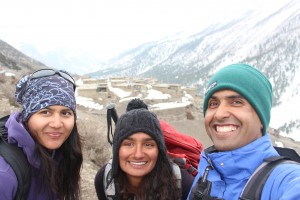October 13, 2016
The following post is part seven of a seven-part series where JSG grad students reveal what they were up to over summer break. Enjoy!

Before I started my PhD at UT Austin with David Mohrig, I spent a year pursuing research projects and traveling as a Watson Fellow. During my stay in the Annapurna region of Nepal, I worked with a Nepali student and guides to install water loggers and collect water, snow, and ice samples. Our research goal was to understand the contribution of snow and glacial ice melt water to river flow prior to the onset of the summer monsoon season. This was the first project where I had to work independently in the field so I was excited to complete a paper once returning to the US. I originally thought that understanding the water logger and isotope data would be as straightforward as measuring the data. To facilitate this data analysis after my first year as a PhD student, I decided to spend a month this summer at the GFZ, a national geoscience center in Potsdam, Germany.
During my stay at GFZ with the Geomorphology section, I wanted to make significant progress in understanding the different patterns in the isotope data and the characteristics of the diurnal melt peaks in the water logger data. Instead, I came up with more questions than answers. The discussions with Christoff Andermann, who designed the study, and Dirk Sachse, a biomarker and isotope expert in the section, guided me to pursue more specific aspects of the data. We then tied the different aspects together with Niels Hovius, the section leader.
After a couple of weeks in Germany, I started to focus in on certain aspects of the water logger data to understand the melt signal on the logger furthest upstream. For the isotope data, an exciting story also developed about melt contributions of different tributaries to the Kali Gandaki, the largest river in my area of study. I finished my stay by presenting the new results for both the isotope and water logger data to the section. Giving a talk was a very fulfilling way to wrap up my time in Germany. I am now excited to work towards writing my first lead-author paper on the isotopic study.
It was great to be welcomed into the Geomorphology section at GFZ. I participated in section outings to local lakes and watched the Germany vs Italy soccer match of the European Championship. I also enjoyed exploring the many museums in Berlin and a local park with a zoo, lake, and bier garden called the Tiergarten.